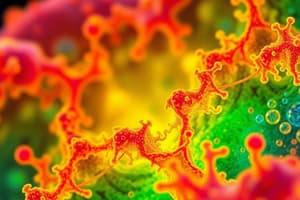Podcast
Questions and Answers
What is the common use of the light microscope in the laboratory?
What is the common use of the light microscope in the laboratory?
- Diagnosing and studying microscopic structures (correct)
- Studying the behavior of living organisms
- Diagnosing and studying macroscopic structures
- Examining the internal organs of organisms
Which type of light microscope has a single eyepiece?
Which type of light microscope has a single eyepiece?
- Bicular microscope
- Monocular microscope (correct)
- Trinocular microscope
- Binocular microscope
How is the total magnification calculated in a light microscope?
How is the total magnification calculated in a light microscope?
- By multiplying the eyepiece magnification by the objective magnification (correct)
- By subtracting the eyepiece magnification from the objective magnification
- By adding the eyepiece and objective magnifications
- By dividing the eyepiece magnification by the objective magnification
What should be done before examining a sample using a microscope?
What should be done before examining a sample using a microscope?
At what magnification should one examine the sample first in a light microscope?
At what magnification should one examine the sample first in a light microscope?
Flashcards
Light Microscope
Light Microscope
A tool used to observe very small objects, often in a laboratory setting.
Microscopic Examination
Microscopic Examination
The process of using a light microscope to observe microscopic structures, often for diagnosis or research purposes.
Monocular Microscope
Monocular Microscope
A type of light microscope with a single eyepiece, used for viewing specimens.
Total Magnification
Total Magnification
Signup and view all the flashcards
Preparing a Microscope for Use
Preparing a Microscope for Use
Signup and view all the flashcards



